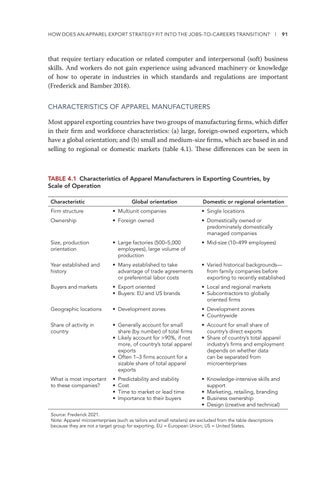How Does an Apparel Export Strategy Fit into the Jobs-to-Careers Transition?
l
91
that require tertiary education or related computer and interpersonal (soft) business skills. And workers do not gain experience using advanced machinery or knowledge of how to operate in industries in which standards and regulations are important (Frederick and Bamber 2018). CHARACTERISTICS OF APPAREL MANUFACTURERS Most apparel exporting countries have two groups of manufacturing firms, which differ in their firm and workforce characteristics: (a) large, foreign-owned exporters, which have a global orientation; and (b) small and medium-size firms, which are based in and selling to regional or domestic markets (table 4.1). These differences can be seen in
TABLE 4.1 Characteristics of Apparel Manufacturers in Exporting Countries, by Scale of Operation Characteristic
Global orientation
Domestic or regional orientation
Firm structure
• Multiunit companies
• Single locations
Ownership
• Foreign owned
• Domestically owned or predominately domestically managed companies
Size, production orientation
• Large factories (500–5,000 employees), large volume of production
• Mid-size (10–499 employees)
Year established and history
• Many established to take advantage of trade agreements or preferential labor costs
• Varied historical backgrounds— from family companies before exporting to recently established
Buyers and markets
• Export oriented • Buyers: EU and US brands
• Local and regional markets • Subcontractors to globally oriented firms
Geographic locations
• Development zones
• Development zones • Countrywide
Share of activity in country
• Generally account for small share (by number) of total firms • Likely account for >90%, if not more, of country’s total apparel exports • Often 1–3 firms account for a sizable share of total apparel exports
• Account for small share of country’s direct exports • Share of country’s total apparel industry’s firms and employment depends on whether data can be separated from microenterprises
What is most important to these companies?
• Predictability and stability • Cost • Time to market or lead time • Importance to their buyers
• Knowledge-intensive skills and support • Marketing, retailing, branding • Business ownership • Design (creative and technical)
Source: Frederick 2021. Note: Apparel microenterprises (such as tailors and small retailers) are excluded from the table descriptions because they are not a target group for exporting. EU = European Union; US = United States.


